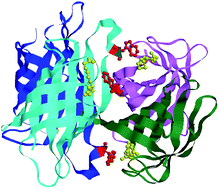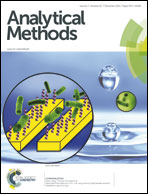A novel molecular biosensor system model designed by using a couple composed of a fluorescent mutant binding protein and fluorophore-labeled ligand analogue based on the FRET mechanism
Abstract
Molecular biosensors represent a powerful form of biotechnology. In this study, a novel molecular biosensor model was designed based on fluorescence resonance energy transfer (FRET) that was carried out by using a couple composed of a genetically engineered fluorescent mutant binding protein and fluorophore-labeled ligand analogue. The pair of streptavidin and biotin was used as a model here. Trp120BFLAF mutant streptavidin (a fluorescent unnatural amino acid named BODIPY-FL-aminophenylalanine (BFLAF)) was position-specifically incorporated into the Trp120 position of streptavidin by a four-base codon method. The FRET occurred when the Alexa546-biotin was added into the Trp120 BFLAF mutant streptavidin. Furthermore, the FRET between Trp120BFLAF mutant streptavidin and Alexa546-biotin decreased by the competitive addition of natural biotin. This result demonstrated that by measuring the FRET, a couple composed of a genetically engineered fluorescent mutant binding protein (Trp120BFLAF mutant streptavidin) and fluorophore-labeled ligand analogue (Alexa546-biotin) was applicable for the quantification of the small ligand (free biotin) as a molecular biosensor system.


 Please wait while we load your content...
Please wait while we load your content...